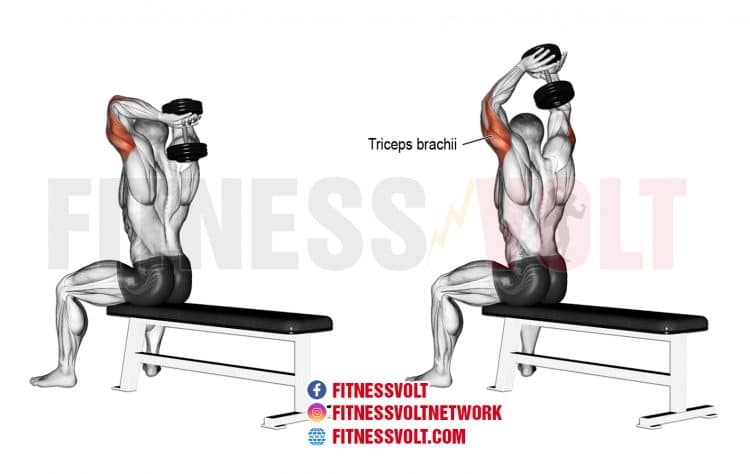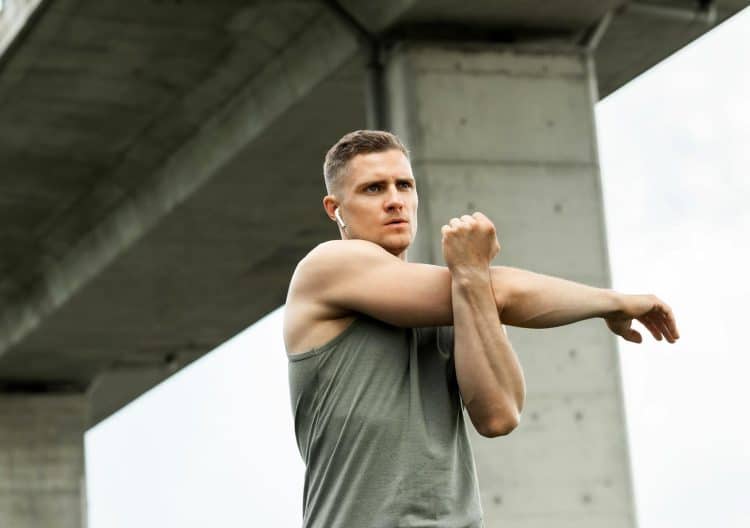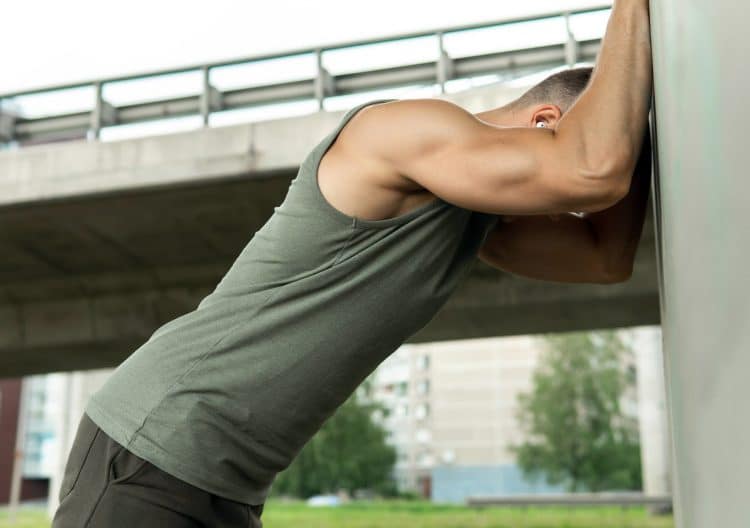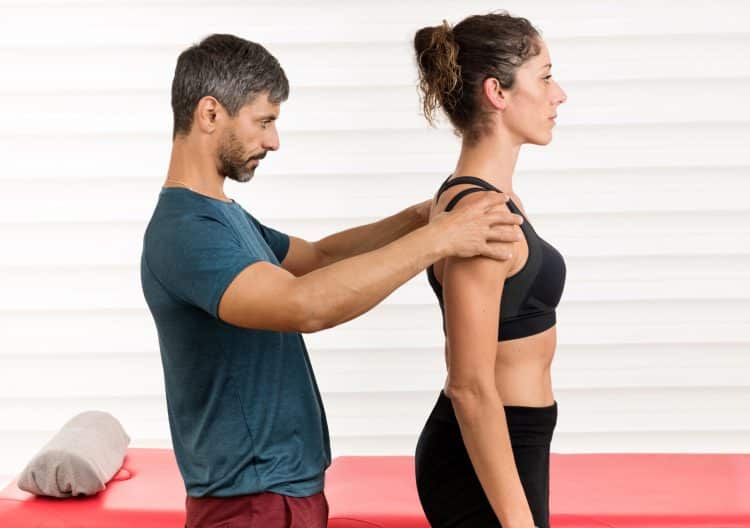The overhead triceps extension, also known as the French press, is one of the best ways to target the long head of your triceps. Hitting this triceps head means putting your arms into flexion, and the best way to do this is to raise them overhead.
Overhead triceps extensions take the target muscles through a large range of motion and provide the triceps with a deep stretch at the bottom of each rep. If you are serious about developing horseshoe triceps, overhead extensions are an excellent option.
However, this exercise has a downside: it can also cause shoulder pain. Pain in the stabilizing muscles is only to be expected and nothing to worry about. In contrast, joint pain could indicate that something more serious is wrong and needs fixing.
In this article, we reveal the possible causes of shoulder pain while doing overhead triceps extensions and how to prevent it.
Causes of Shoulder Pain During Overhead Triceps Extensions
There are several reasons that overhead triceps extensions can cause shoulder pain. Some are easy to fix, while others are less so. Some causes of shoulder pain may require rest or medical attention.

Use the following information to determine why overhead triceps extensions hurt your shoulders.
Poor mobility
Overhead triceps extensions involve raising your arms so your biceps are next to your ears. This requires above-average shoulder joint mobility, and your lats, pecs, and delts must also be flexible.
Tight muscles or immobile joints mean you’ll have to strain to get your arms into the correct position for overhead triceps extensions. Needless to say, if this is difficult for you to do, shoulder pain may be the result.
Related: Five-Minute Mobility Workout for Lifters
Improper technique
Many lifters turn overhead triceps extensions into a bastardized behind-the-neck overhead press. This may be because they lack the mobility necessary to get into the right position, are using too much weight, or simply don’t know any better.
There are two ways to perform most exercises – the right and the wrong way. The right way is generally safe, comfortable, and keeps the tension on the target muscles. The wrong way compromises your joints, takes stress off the target muscles, and is more likely to cause injuries.
Overhead triceps extensions are quite an unforgiving exercise, and even small technical errors can cause pain in all the wrong places.
Poor posture
Posture is the alignment of your joints, and it can be good or bad. Bad posture, such as rounded shoulders or slouching, makes it much harder to get into the correct position to do overhead triceps extensions safely.
This poor posture means you’ll need to change your technique to perform the exercise. Invariably, this puts more stress on your shoulders than it does your triceps.
Using too much weight
Overhead triceps extensions are an isolation or single-joint exercise. Once your upper arms are next to your head, only your elbows should move. Such a strict movement means you won’t be able to lift a lot of weight. As a result, overhead triceps extensions work best with light to moderate loads and medium to high reps.
However, despite this, some exercisers try to use very heavy weights with overhead triceps extensions, which puts a lot of stress on all the muscles and joints involved, including the shoulders.
An underlying shoulder problem
Shoulder problems are common among bodybuilders and weightlifters. The shoulder is a very hard-working joint and is involved in virtually every upper-body exercise you perform. As such, many lifters have chronic shoulder problems, such as bursitis, tendonitis, strains, and sprains.
While you might be able to do some exercises without pain, the overhead triceps extension involves an awkward arm position. Because of this, they may aggravate any existing shoulder injuries.
Not warming up properly
Warming up is crucial as it prepares your body for the workout and exercises you are about to perform. Overhead triceps extensions need a thorough warm-up because of the position of your arms. Not warming up could mean your shoulders feel stiff and immobile, which could cause pain if you force your upper arms up and next to your ears.

Poor shoulder stability and strength
While overhead triceps extensions are undoubtedly an arm exercise, you need strong, stable shoulders to keep your biceps next to your ears. Weak deltoids or unstable joints could cause shoulder pain, despite not targeting them directly.
Lack of shoulder muscle endurance could also mean your deltoids fatigue before your arms, and you’ll feel them burning painfully toward the end of your set.
Overhead triceps extensions don’t suit your body type
Exercise is good for everybody’s body. However, because of biomechanical differences such as shoulder width and arm length, not all exercises suit all lifters. Despite warming up, using good form, and lifting a sensible weight, overhead triceps extensions may still hurt your shoulders.
It’s not the exercise’s fault, but your genetics. Don’t worry, though; there are other ways to train your triceps long head.
How to Prevent Pain When Doing Overhead Triceps Extensions
Now that you know the possible causes of shoulder pain when doing overhead triceps extensions, here are some strategies to avoid it.
Warm up properly

Warming up increases tissue temperature, blood flow, joint mobility, and muscle flexibility. These things make getting your upper arms into the correct position to do overhead triceps extensions easier, reducing the risk of shoulder pain.
Focus on your shoulders, upper back, and elbows when preparing for overhead triceps extensions.
A warm-up for strength training should include the following:
- Pulse raiser (light cardio)
- Joint mobility
- Dynamic flexibility
- Movement prep/practice reps
Read more about warming up for strength training here.
Stretch your lats and pecs
It’s generally best to avoid statically stretching muscles before training them. Static stretches can reduce force production and make you weaker. However, with overhead triceps extensions, stretching your pectoralis major and latissimus dorsi should make achieving and maintaining the correct arm position easier.
Don’t worry about losing strength for your workout, as these muscles are not directly involved in overhead triceps extensions.
Check out this article to learn more about stretching your pecs and this article to discover the best exercises for stretching your lats.
Practice and perfect your technique
While overhead triceps aren’t the most technical bodybuilding exercise, they’re not the simplest, either. If you are new to this movement or have picked up some bad habits and don’t do them as cleanly as you should, it’s time to start practicing and mastering your form.
Do this exercise with a light dumbbell to ensure you are performing it correctly. Use a mirror or training partner for feedback. Also, consider videoing yourself for a post-set analysis. Do practice sets before your main workout and a few more before or after your other workouts so you can work on your form.
Fix whatever technical errors you spot to reduce your risk of shoulder pain.
Try using different training implements
There is more than one way to do overhead triceps extensions. Dumbbells might be the most common, but you may find cable or barbell overhead triceps extensions more common. You can also use an EZ bar or a “triceps bomber” bar, which has parallel grips.
All these options put your hands and upper arms in a slightly different position, which may be more comfortable for your shoulders.

Use lighter weights and a slower tempo
If heavy weights hurt your shoulders, but light weights don’t challenge your triceps enough, try doing your reps more slowly. So, instead of the usual one-second up/one-second down tempo most lifters use, try a 2:2 or 3:3 tempo.
Lifting and lowering more slowly makes light weights feel heavier while taking stress off your joints.
You don’t have to lift heavy weights to fatigue your muscles; a slower tempo and light weights can be just as challenging.
Strengthen your rotator cuff
Overhead triceps extensions require strong rotator cuff muscles to stabilize your shoulder joint. The rotator cuff is the collective name for the small muscles beneath your deltoids.
The muscles that make up your rotator cuff are:
These muscles are often weak and the cause of many shoulder problems. Strengthen your rotator cuff by performing cable or resistance band internal and external rotations.
Fix your posture
Poor posture, especially a slouched upper back and rounded shoulders, makes it impossible to get your arms into the correct position to do overhead triceps extensions. Trying to do this exercise when you’ve got bad posture puts a lot of stress on the shoulders.
Pronged sitting and too much time using screens mean that many people have poor posture.
It’s beyond the scope of this article to tell you how to fix your posture, but stretching your chest and strengthening your upper back with face pulls and band pull-aparts will help. Mobilizing your thoracic spine will also be beneficial.

Get any underlying shoulder problems diagnosed
If your shoulders hurt despite using these tips, you may have an underlying joint, tendon, or muscle problem that needs diagnosing and fixing. While muscle pain in the areas you are training is normal, pain in nearby muscles and joints is not.
Pain is your body’s way of saying something is wrong, and it’s best not to ignore it. Training through pain is a great way to make minor injuries worse.
If overhead triceps extensions hurt your shoulders, stop doing them and find out the source of your pain.
Use alternative exercises
While overhead triceps extensions are an effective exercise, they aren’t the only way to target the triceps long head. There are other exercises that are just as effective but put much less stress on your shoulders.
Good options include:
Take overhead triceps extensions out of your workouts and do any of these shoulder-friendly arm exercises instead.
Frequently Asked Questions
Do you have a question about shoulder pain and overhead triceps extensions? That’s okay because we’ve got the answers!
1. I had sudden shoulder pain during overhead triceps extensions. What should I do?
Sudden onset or acute pain suggests you may have strained a muscle or sprained a ligament. In either case, you should stop what you’re doing to avoid making your injury worse.
Depending on the severity of the damage, you may also need to use RICE (Rest, Ice, Compression, and Elevation) to promote recovery.
Do not return to training until the pain has subsided. If the pain is severe, get it checked out by a medical professional. You can still work out, but you must avoid aggravating the injured area. Train around the injury and not through it!
2. Are overhead triceps extensions safe?
Overhead triceps are not the riskiest triceps exercise, but nor are they the safest. They tend to place a lot of stress on the shoulder joint and can be uncomfortable. However, providing you have stable, mobile shoulders, and perform them with good form, it would be an exaggeration to say that overhead triceps extensions are dangerous.
3. Do I even need to train my long triceps head separately?
While isolating any of the three triceps heads is impossible, you can emphasize each one by altering the position of your upper arm. Bodybuilders often do this to create the perfect horseshoe-shaped triceps.
However, suppose you are a recreational lifter who doesn’t care about developing a championship-ready physique. In that case, you probably don’t need to train the long head separately. General triceps training will most likely give you the results you want.
4. Can I do overhead triceps extensions even though they hurt my shoulders?
Just because you can do something doesn’t mean you should! Pain is your body’s way of telling you to stop and that something is wrong. Training through pain is a good way to turn a minor injury into something more significant.
If overhead triceps extensions hurt your shoulders, try to determine the cause of the problem and then apply the solutions outlined in this article. And remember, the overhead triceps extension is NOT compulsory, and there are plenty of other exercises you can do that are far more shoulder-friendly.
5. Are single-arm triceps extensions safer or better than the two-armed version?
We all respond to exercises differently, and you may find that single-arm overhead triceps extensions are more comfortable than the regular version. Try them and see! They involve a very similar movement, but using one arm at a time means you may be able to position your shoulder at a more forgiving angle. You can also use your free arm for stability and support.
Closing Thoughts
Just because overhead triceps extensions are effective for building muscle doesn’t mean you have to do them. If they bother your shoulders, you should seek alternatives. After all, there are plenty of similarly effective exercises that target the long head of your triceps.
However, if overhead triceps extensions hurt your shoulders, it may not be the fault of the exercise. For example, your shoulder pain could be the result of poor posture, inadequate mobility, a weak rotator cuff, or using too much weight.
Fix these problems, and you may find that overhead triceps extensions no longer cause discomfort.
Remember, though, you should avoid training through pain. Don’t ignore it, as it could be an indicator that something is wrong. The pain could get worse if you fail to do something about it.
Read also:
